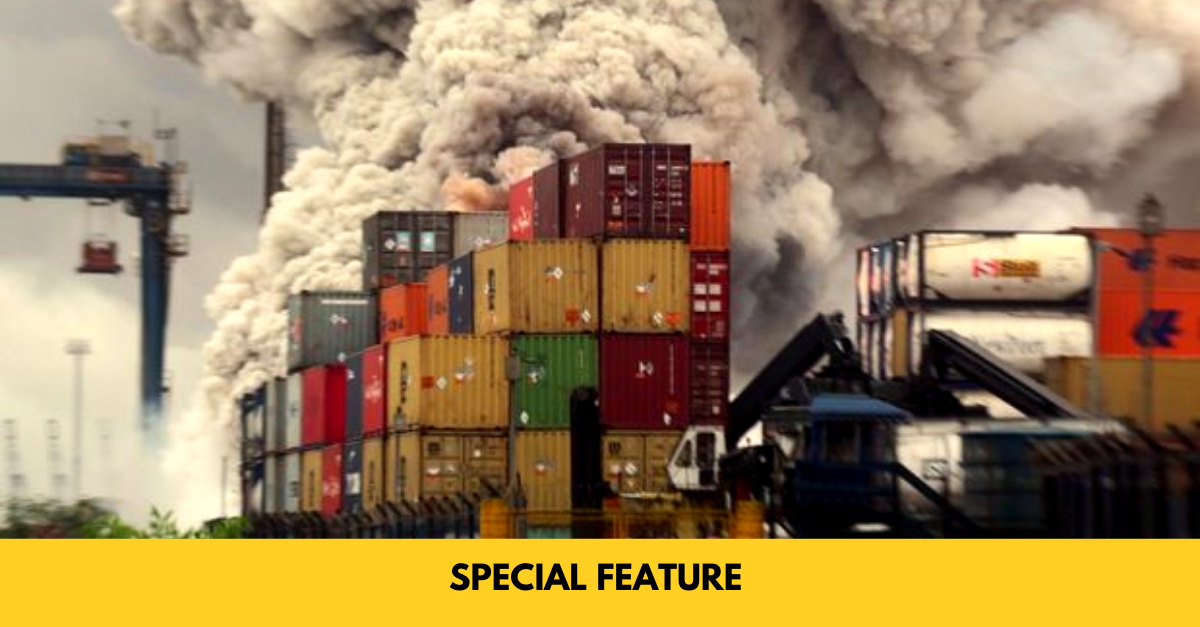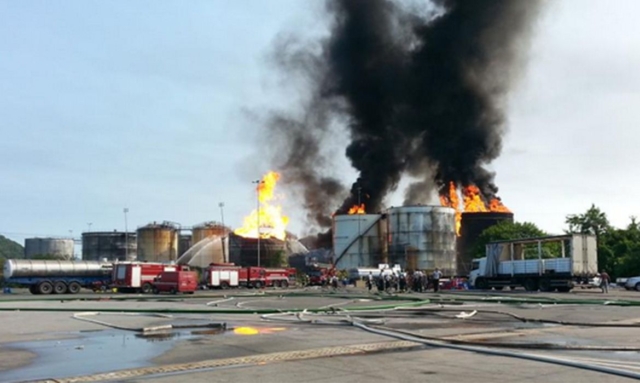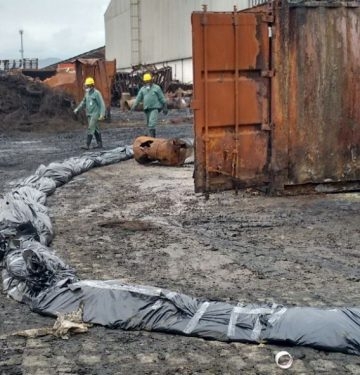
What is being done about hazardous cargo in Brazil, post Beirut?
Oct, 07, 2020 Posted by Sylvia SchandertWeek 202041
Ever since the catastrophic ammonium nitrate conflagration in Beirut on August 4th which led to over 200 deaths and more than 6,500 injured, port operators around the world have been taking a serious look at their handling of hazardous cargoes.
None more so than in Santos, Brazil’s leading port for containers and also for hazardous cargoes in boxes, which handled 45.7% of all dangerous cargoes on East Coast South America in the first seven months of this year – equivalent to 42,869 TEU.
How Brazilian authorities have reacted
A three-week investigation called ‘Operation Relic’, designed to do an audit of all dangerous cargo at the Port of Santos, began on September 21st, led by IBAMA (the Brazilian Institute for the Environment and Renewable Natural Resources).
“Ever since the Beirut explosion, the Brazilian authorities have been trying to brush up the rules and regulations and oversight and it’s paying off,” said one terminal manager in Santos, who wished to remain anonymous. “We have seen many more officials and there are moves to bring in more regulations to make sure this does not happen in Santos, where a lot of fertilizer is imported both in bulk, breakbulk and in containers to feed our ever-growing agribusiness sector. After the Ultracargo and Localfrio fires [in 2015 and 2016], we also had many more rules, regulations, and monitoring come into play. I hope the authorities focus on the right areas and don’t create too many bureaucratic obstacles just for the sake of it.”
His thoughts were echoed by Luis Resano, the executive director at the Association of Brazilian Cabotage Shipowners (ABAC), which has formed a new committee to monitor safety issues in Brazil for its members: the Quality, Safety, and Healthy Environment committee.
“It’s very difficult to obtain 100% security and safety for all cargoes, but we try to get as close to it as is possible,” he told Datamar news. “We can transport dangerous goods, but we must always take all the measures to prevent accidents. What happened in Beirut was sheer negligence and they did not take care of these safety issues.”
“We have many large companies, such as Braskem, who our members deal with on a regular basis, so it’s easier to monitor them. With Braskem, and big outfits like them we now know nearly all their cargoes and what safety measures are required, but with other smaller outfits we do not always have so much data, and misdeclarations of hazardous cargoes are often a cause for concern.”
Resano also added that at the start of October, a taskforce was set up with IBAMA (the Environmental agency) and ANTAQ (agency for ports and waterways) along with the public Ministry of Justice which are looking at new ways of managing dangerous goods.
Incidents in recent past
The port of Santos has had a sad history of fires breaking out, with the worst one being the 2015 accident at the Ultracargo terminal (See photo below), at Alemoa on the right bank of the port.
That conflagration at Brazil’s largest liquid bulk storage facility took nine days and 80 firefighters to quell, and the thick black smoke could be seen for miles around and caused the main entrance road into the port to be closed for several days. A thick black cloud filled the sky for more than 48 hours and many residents in surrounding areas went to the hospital with respiratory problems.
According to Grupo Ultra, the owners of the site, the terminal was used to store fuels (including ethanol and gasoline), chemicals, vegetable oils, ethanol, and various corrosive products. Five vessels at the neighboring Brasil Terminal Portuaria (BTP) box terminal were re-routed away from the area.
The Ultracargo accident was followed by a January 2016 chemical fire at the Localfrio container storage facility on the left bank of the port (see photo below), in Guarujá, which hospitalized 66 workers. At first, it was thought that the thick, acrid smoke contained a dangerous mix of ammonia, but it was eventually traced back to a release of less-toxic chemicals, mostly chlorine. Some 66 people were taken to the hospital with severe respiratory problems and the nearby Tecon Santos box terminal, operated by Santos Brasil, was closed temporarily.
Firefighters at the time said rainwater had seeped into around 20 containers causing a chemical reaction.
Mario Antonieta de Brito, mayor of Guarujá, asked people to stay out of the rain which could “contain chemical elements that can burn the skin”.
Also, in 2013, the Copersucar sugar terminal saw 180,000 tonnes of sugar catch fire and damage four warehouses.
And it is not just Santos.
In August of this year at the Chibatão Port container terminal, which serves the Manaus industrial complex and free-trade zone, a lightning strike caused a fire in one container which spread to 35 others in close proximity, some of which contained gas and sulfuric acid, causing an explosion. A toxic smell was experienced in the vicinity of the terminal.
Therefore with the port of Santos playing such a key role in the economy of Brazil – hosting around 28% of all foreign trade and 40% of its containerized trade – it is highly important that major fires and accidents are kept to a minimum, but with so many liquid bulk facilities in the port and so many hazardous goods being shipped by container, 100% safety will never be achieved concede nearly all port users.
“Unfortunately, it is not possible to guarantee 100% safety all the time,” said Resano, of ABAC, and that sentiment was echoed by several other voices interviewed for this article. “But we can try as best we can to take measures that get as close to 100% as is humanly possible, without making transportation of such goods economically unfeasible.”
ABAC represents six Brazilian flag shipping lines (Aliança Navegacão, Log-In Logistica, Mercosul Line, Norsul, Flumar, and Hidrovias, which started as a barge operator with iron ore and soy and now also owns two vessels and moves bauxite around the Brazilian coastline), and also works closely with Syndarma (the association of Brazilian flag shipowners), where Resano worked in a similar role for nearly a decade.
Hazardous cargo trade on East Coast South America
In terms of the East Coast of South America trade lane, the port of Buenos Aires (including TRP, BACTSSA, and terminal 4 at Puerto Nuevo, plus Exolgan at Dock Sul) comes in second to Santos (see table below), with around 16.4% (44,014 TEU) of the overall total handled since the beginning of 2019 (when Datamar started recording these numbers) until the end of July. BA handled 15,448 TEU during the seven months of 2020 up to the end of July, down from 15,142 TEU last year, but maintaining a 16,5% market share of all ECSA hazardous cargo handlings in boxes.
Paranaguá, in the southern Brazilian state of Parana, comes third in ECSA, and second in Brazil, with 17,656 TEU (from January 2019 to the end of July 2020) and 6.6% of ECSA’s overall total for the full period.
Montevideo, in Uruguay, (with 16,944 TEU) followed by Itapoá (12,194 TEU) make up the top five ECSA ports for dangerous cargoes.
During the first seven months of 2020, Paranaguá performed well (with more than 6,000 TEU) and nipped into third place, overtaking Montevideo, followed by Itapoá, Salvador, Navegantes, and Zarate, in Argentina.
Although Maersk Line, MSC, and Hamburg Sud lead carrier charts for most indices, when it comes to dangerous cargoes it is the German carrier Hapag Lloyd that rules the roost (see pie chart below).
For the 19-month period (January 2019 to end July 2020) Hapag Lloyd carried 72,842 TEU to/from ECSA ports which gave them a 27.2% market share. They were followed by Hamburg Sud, with 24.4% share (65,355 TEU), then MSC with 12.1% (32,363 TEU), Maersk Line with 10.6% (28,385 TEU), and CMA CGM with an 8.3% share (22,217 TEU).
Hapag Lloyd was not available to comment, but one consultant in Santos, who is familiar with these matters, said that the German company has a number of long-term contracts with a few major pharmaceutical companies and that is why they lead the way in the ECSA table.
Ocean Network Express (ONE) comes in at a respectable 6th place with 6.7% market share and 18.031 TEU, with good volumes of hazardous cargo being shipped via both Santos and Buenos Aires, where the Japanese-owned carrier uses the Exolgan terminal at Dock Sul, which is close to the chemical and petro-chemical terminals for the region.
Patrick Campbell, the President of ONE in Argentina, said that the authorities in Argentina have been making sure everything is in order vis a vis hazardous cargo in the wake of Beirut. In Buenos Aires, the Administracion General dos Puertos has responsibility for making sure the terminals are adhering to safety procedures, and the AGP works closely with the Ministry of Defense and other government departments.
Campbell told Datamar News that the most common dangerous goods shipped through the port of BA by his line and others were “chemicals and fertilizers” but also, airbags for the automobile industry for ONE. Both Buenos Aires and the ABC (Santo Andre, Sao Bernardo, and Sao Caetano) region between Santos and Sao Paulo are prolific auto manufacturers and there is a lot of exporting back and forth between the two Mercosur trade bloc countries.
Further considerations over safety
Peter McKay, Editorial Director for the long-standing and highly reputed sector specialist magazine Hazardous Cargo Bulletin (HCB), said that since the Beirut catastrophe, regulators have been sharpening their teeth around the world to try and improve safety procedures and monitoring.
“With regard to what happened in Beirut, Ammonium nitrate is, of course, regulated under the IMDG Code and, if the regulations are followed, there should not be any further problems,” explained McKay to Datamar News.
“Where the issues arise – and this is also true of the Tianjin explosion [which killed 173 people after an explosion in a container storage station in August 2015] – is when the product is being stored ashore, especially if – as was the case in Beirut and Tianjin – it is being done so in an unsafe manner.”
“Operations within port areas would likely fall under national legislation (e.g. in the United Kingdom it’s HSE’s Dangerous Goods in Harbour Areas Regulations 2016), and outside the immediate port area they would come under other industrial or H&S legislation (e.g. in the UK it’s COMAH – the Control of Major Accident Hazards Reg ulations).”
“Both in Beirut and Tianjin there seems to have been an element of intentional avoidance of any regulations, and the authorities were either unaware of the hazards or chose not to act.”
In Brazil, the monitoring and regulation of safety issues within the port areas come under the auspices of ANTAQ (responsible for ports and waterways) and IBAMA (covering environmental safety), and sometimes local governments. In Santos, for instance, the city administrations (mayors) of Santos and Guarujá (the respective right and left banks of the port of Santos) will be involved, as will various departments of the state government of Sao Paulo in the city of Sao Paulo. All these authorities will then collaborate and report back to the Santos Port Authority (formerly CODESP, which is currently being privatized), before a final decision is taken.
“Unfortunately, in some ways, too many cooks spoil the broth,” said one heavily involved association executive which uses the port of Santos, but who wished to remain anonymous. “Sometimes these various bodies have their own agendas and try and flex their muscles for political reasons and that can cause delays in implementation of safety measures.”
Outside the port areas, responsibility for the safe handling of hazardous cargoes comes under the Agencia Nacional de Transported Terrestres (ANTT, or Brazilian National Agency of Land Transportation). They will take responsibility for storage areas outside ports and for the movement of dangerous cargoes via trucks.
In terms of Santos and dangerous cargoes handled in containers, the loads are shared between the three principal terminals – Brasil Terminal Portuaria (a joint venture between MSC Line’s Terminal Investment Limited (TIL) and Maersk Line’s AP Moeller Terminals), DP World Santos and Bovespa quoted Santos Brasil’s Tecon Santos – but DP World may have slightly more as they host Hapag Lloyd’s US Gulf and Caribbean service, and Hapag is the leading carrier in the handling of hazardous goods in containers. Hapag’s Asia service currently calls at Santos Brasil and that brings in a fair number of hazardous cargo boxes.
Gustavo Costa, a container logistics’ researcher at the University of Sao Paulo (USP), and former logistics and cabotage trades executive for Hamburg Sud for more than 20 years, also underlined Resano’s earlier comments that “nothing was 100% safe”, but a continuous process of inter-acting with shippers was essential to keep the hazardous cargo logistics chain as safe as possible.
“Nothing is 100% safe in this area but when I was with Hamburg Sud, we spent a lot of time passing on to customers reminders about all the regulations; not just on safety and storing of dangerous cargoes but also drug trafficking.”
“Our main concern was that they were contracting container terminals to store the cargoes without checking what they were doing. A big chemical client found leakages of liquids and we found that the guys were making use of 100% of the container space and moving and turning the cargoes upside down and sideways which caused dangerous liquids to leak.”
Costa said that with tank containers it was easier to control safely as you just clean out the container for the next cargo if it is leaking. “Our main concern was dangerous cargoes that were NOT in tank containers,” emphasized the experienced Costa. “We spent a lot of time going over the procedures, training clients to make sure they knew what the safety procedures were.”
Datamar News spoke to several managers and executives at port terminals in Santos and they emphasized several times the importance of the correct stacking of various dangerous goods.
“It is extremely important to get the stacking right, and to keep boxes containing hazardous goods away from other boxes and to space them out,” said one terminal manager.
“We handle imported airbags here, for automobiles, and they have a kind of explosive in them. Therefore, we have separate places to store them, so if one explodes it will not affect the other containers. And with gasoline and cotton, it is the same.
“There are parameters which can be followed to reduce risk, and cargo compatibility is already part of the parameters of Navis. Its systems already show up the algorithms to allow the separation of dangerous containers from other hazardous cargoes.”
Luiz Araujo, the commercial director for Ecoporto Santos, a breakbulk facility with several ship-to-shore Gantry cranes which used to be the port’s number three box facility and still handles containers, echoed the importance of correct stacking of dangerous cargoes and added that trucks must be ready to take some IMO-class dangerous cargoes immediately out of the port areas to safer warehousing locations.
“We handle both export and imported dangerous cargoes at Ecoporto,” said Araujo. “Some dangerous cargoes are not allowed to be stored in the port areas and must be directly discharged or directly loaded [onto trucks for onward transport].”
One Ecoporto customer is Avibras Industrial Aeroespacial SA, headquartered in the Paraiba Valley, in Sao Paulo state, which produces tanks for export as well as the missiles that go with them.
“Brazil has a good reputation for armored tanks as most are tested in our rugged jungle areas, in difficult terrain, and during the Iraq-Iran war they provided tanks to both sides!”
Clearly, Ecoporto has a lot of experience in handling hazardous cargoes, both breakbulk and in containers, including ammonia nitrate for the fertilizer industry and for agribusiness. BBC Chartering and Grimaldi are the two key carriers working out of Ecoporto’s Santos terminal.
Araujo welcomed the authorities bringing in more stringent checking in the wake of Beirut, but he hopes they do not go too far.
Some years ago, a fatal fire in a Porto Alegre (Rio Grande do Sul) nightclub led a massive clampdown on fire regulations throughout Brazil, in all sectors, including ports.
“Our warehouses now have to have to have different kinds of fire brigades on standby and have sprinklers all over the warehouse because of that Porto Alegre incident,” explained Araujo. “And so, following the horrible incident in Beirut, the authorities here will probably implement new measures here in Santos.”
Source: Rob Ward for DatamarNews
-
Grains
Jun, 11, 2021
0
China accesses federal reserves to rein in commodity prices
-
Ores
Jul, 26, 2021
0
Bahrain again importing iron ore from Brazil
-
Grains
Dec, 29, 2022
0
Grain exports in Argentina exceed US$ 3 billion under ‘soy dollar’ program
-
Trade Regulations
Oct, 26, 2021
0
Brazil and Colombia sign agreement to promote exports and investments between the two countries



